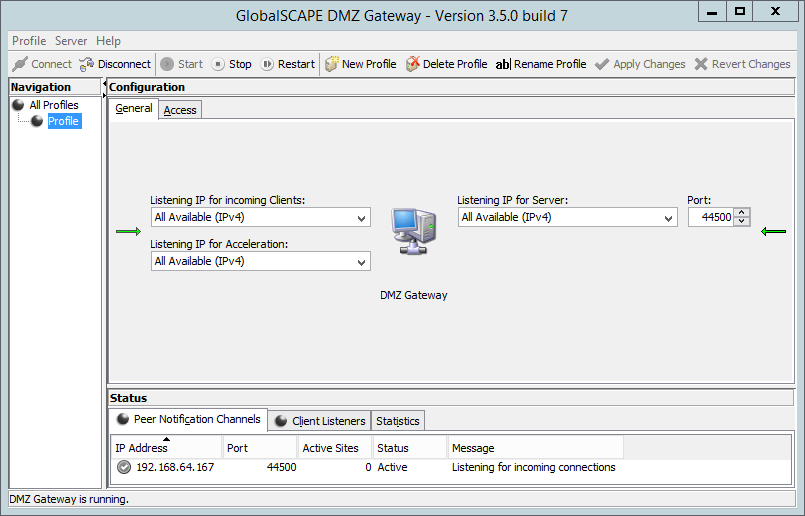The DMZ Gateway Interface
The DMZ Gateway interface is used for mapping and viewing DMZ Gateway connections. Profiles are used to define connections to DMZ Gateway.
To open the interface
-
On Windows systems, double-click the DMZ Gateway shortcut on the desktop or Start menu.
-
On non-Windows systems, after the server service has started, execute the DMZ Gateway administration interface script (for example, /opt/dmzgateway/bin/DMZGatewayadministrator). On SuSe Linux, you must be logged in as root to launch the administration interface.
-
The left pane displays each of the defined Profiles in an expandable/collapsible tree view. DMZ Gateway has a default Profile for which you define the listening IP address(es) and port for the connecting application, listening IP address(es) for connecting clients, and the IP address ban list. When DMZ Gateway connects, only the default Profile is displayed. The interface displays the configuration for the last Profile modified or viewed the last time the interface was opened or the first (default) Profile if no "last viewed" profile value is available.
-
In the default view, with All Profiles selected, the right pane displays the status of the DMZ Gateway service and the status of all Profiles.
-
When a Profile is selected, the right pane displays the configuration information and status of the selected Profile.

DMZ Gateway Administration Interface PID File
When the DMZGatewayadministrator executable is launched it will create the PID file <Installation Directory>\DMZGatewayadministrator.pid. This file contains the PID for the administration interface process. The timestamp of the file is updated every 10 seconds while the administration interface is running. When the application exits gracefully, it deletes the PID file.
This file is also used to prevent simultaneous execution of multiple copies of the administration interface. When the administration interface starts, it checks for the presence of the PID file. If the file exists and its timestamp has been updated in the last 20 seconds it will assume another copy of the user interface is running and exit.
Related Topics
-
Refer to Creating a Profile for information about Profile configuration.
-
Refer to Controlling Access by IP Address for information about granting or denying access to a specific IP addresses or an IP mask.
-
Refer to Starting and Stopping the DMZ Gateway Server Service for details of stopping and starting the DMZ Gateway server service.
-
Refer to Viewing Statistics for details of each of the tabs in the Status pane.